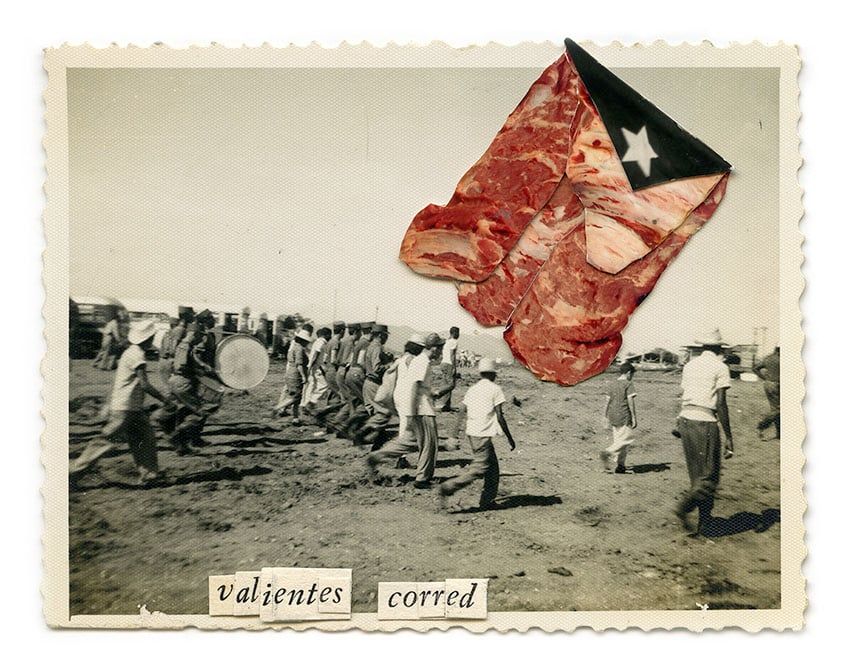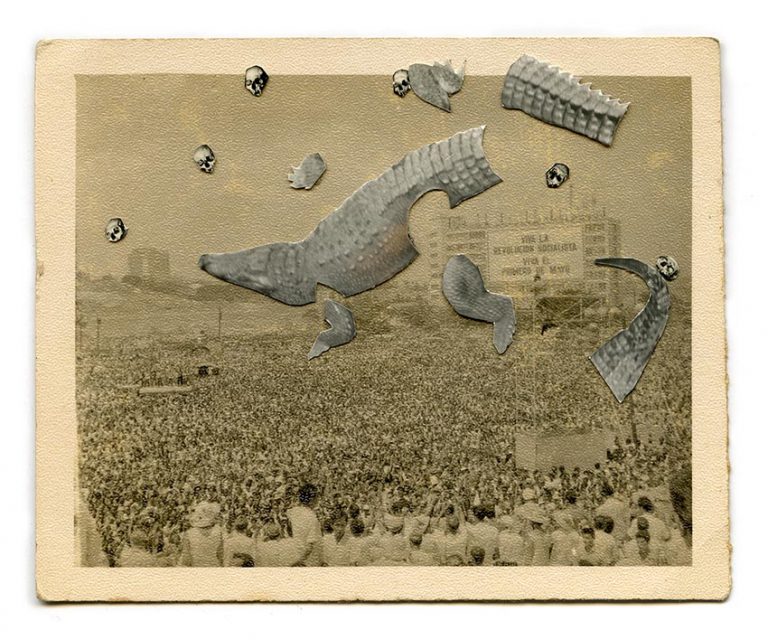Ricardo Miguel Hernández “examines” contemporary collage with a cross-border perspective. His palimpsests —let’s call them that— show how alive this art (collage) has been preserved as a concept, episteme and sensibility since it began to be shaped at the beginning of the 20th century by Pablo Picasso and Georges Braque, or even earlier, at the end of the 19th century.
From its beginnings, collage built a new aesthetic scenario that dissolved the traditional forms of representation. To put it simply, what collage did, as a visual grammar (language), was to put representation in crisis.
From a Derridian point of view, “representation” is nothing more than translation. By abandoning the illusionism of “representation,” a (disfigured, undone, ruinous) translation is produced that introduces the powers of interruption and montage. Let’s say it from the beginning, the collages of Ricardo Miguel (Havana, 1984) are nothing but debris: tortured architecture.
They are images where an intertextual, carnivalesque, hybridized look stands out, subverting some codes of representation, making use of them and validating, behind an essentially fragmented attitude, their functionality, which allows him to bear testimony, perhaps hyperbolized, of a performative action that is apparently far from everything linear.

They are images and they are discourses. Discourses presented, but, in their very making, they give the illusion of unrepresentability. Julia Kristeva said that what is unrepresentable is “that which, through language, does not form part of any particular language. That which, through meaning, is intolerable, inconceivable: the horrible, the abject”. It is that, the abject. It is a map of liminal —abysmal— states that question the modes of its own representation.
Hernández’s discourse, in this sense, brings together an extensive and unstable amount of heterogeneous materials and discourses. His pieces, in turn, derive their meaning from the different (not only) photographic (critical) discourses from which they are born. Note that here I refer to discourse not simply as that which “translates the struggles or systems of domination, but that for which, and by means of which, one struggles,” in Foucault’s words.
They can be collages thought of as parasitic on the original work(s). But I also propose to think of them as saprophytes, feeding, like fungi, on decaying matter, that is, feeding on the ruins.
Starting from the change in the relationship of the artistic text with mimesis and with the values and assumptions of realism, collage, as a path of creation, formed labyrinthine networks of possible references in an exercise of varied and free hybridizations. A change, above all, that operated in the illusionism of (dis)assembly.
This new aesthetic scenario (I refer to aesthetics beyond its traditional understanding, with a trans-artistic meaning: aesthetics as the “science of sensual cognition,” as Baumgarten, its founding father, called it) allowed collage to become a gesture of intertextualization that challenged the assumptions of artistic closure, originality, uniqueness and autonomy, and the “capitalist” notions of possession, property and “will to truth.”
Avant-garde collage would take to another level “the chance encounter on a dissecting table of a sewing machine and an umbrella” —according to Lautréamont— and produced a new aesthetic of contingency and incendiary juxtaposition. It produced a realm of otherness.
With the arrival of the Postmodern, in a post-industrial, post-structural era, in the phase of Fredric Jameson’s so-called “late capitalism” —”Atomic Age,” in the words of Ihab Hassan—, the cards of sensibility were reshuffled and the notions of collage and montage were placed as central procedures of postmodernity. Collage ceased to be the patrimony of the visual arts (and not only) to become part of the sensibility of an era.

In this cosmos Ricardo Miguel Hernández inserts himself with a huge palimpsest of many layers, with provisional, fluid, relativistic, multiple file… His collage photos aspire to a kind of text that erases the lines of demarcation between the authentic and the inauthentic and declares originality null and void. It goes without saying: the idea of originality has failed.
To insist on an earlier idea, the collages in, for example, the series Cuando el recuerdo se convierte en polvo (2018-2020), can be described as parasitic on original —in the sense of having their source in— photographs/texts collages that are composed of multiplicities, saprophytic texts that feed on the discarded, the unspeakable.
His series demand successive displacements (re-replacements) in a highly fertile transcoding gesture. The character of his pieces, which are modeled with a redemptive vision of the image of mimicry, are essentially disfiguring of the copy and transfigure the impulse of others into authentic expression.
Unjustified margins, openness of the broken, expansive character and intertextual predominance based on a polycentric, rhizomatic and flexible conception, make the collage photos of Cuando el recuerdo se convierte en polvo a mere “echo chamber” (Barthes), where there are no texts but only resonances between them.
Ricardo Miguel’s collage photos are really that: the impossibility of living outside the text ad infinitum.
Hernández studied at the Cátedra Arte de Conducta —where he graduated in 2009—, created and directed by Tania Bruguera. He has exhibited in countries such as Cuba, the United States, Italy, Germany, the Czech Republic, Brazil, Poland and Slovenia.
In another of his series, Nada nuevo bajo el sol (2015-2017), a trilogy of audiovisual materials, he forms an exploratory archive where he spurs the architectures of power; architectures that expand in networks of intermediation. That is why his images are so poetic. For him as for Nietzsche, the theory of power is poetological. Power is “poetic”; it engenders meaning.
Under that power, under that armor, Ricardo Miguel pierces the deflagration.
Nada nuevo bajo el sol gives rise to a filmic promontory of many layers. Each layer is a sunset, captured from the same point, over Havana. Sunset on sunset.
The Cuban creator insists on residual collage-images. Between the fragile and the intertwined, he configures a narrative that questions the totality, the continuity, the monolith to which power aspires. It modifies the authoritarian narrative. It destroys it. It is a sharp blade. A blade that tortures old photographs. That is to say: it tortures memory, and remakes it.
Built from fragmentation, excision and suture, these photographic texts —to call them something— do not aspire to establish a chronology. They aspire to chaos. Chaosmosis is their disease. They are sick images, in the etymological sense of the word: lacking solidity. Here we are not interested in totalizing, but in that uncertainty of the trembling, of the ruins, of the dusty, of the forgetfulness, of the rotten.
















